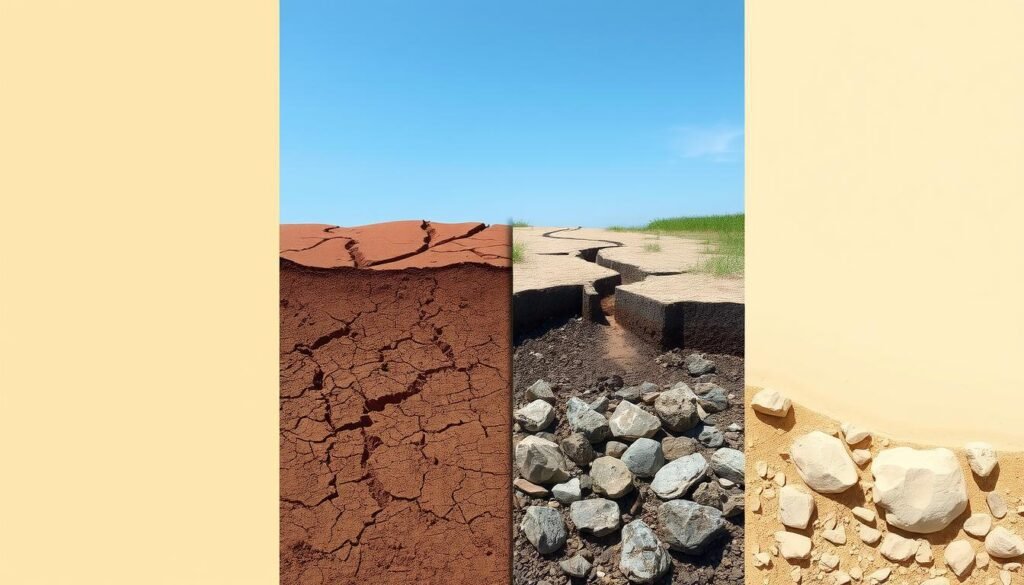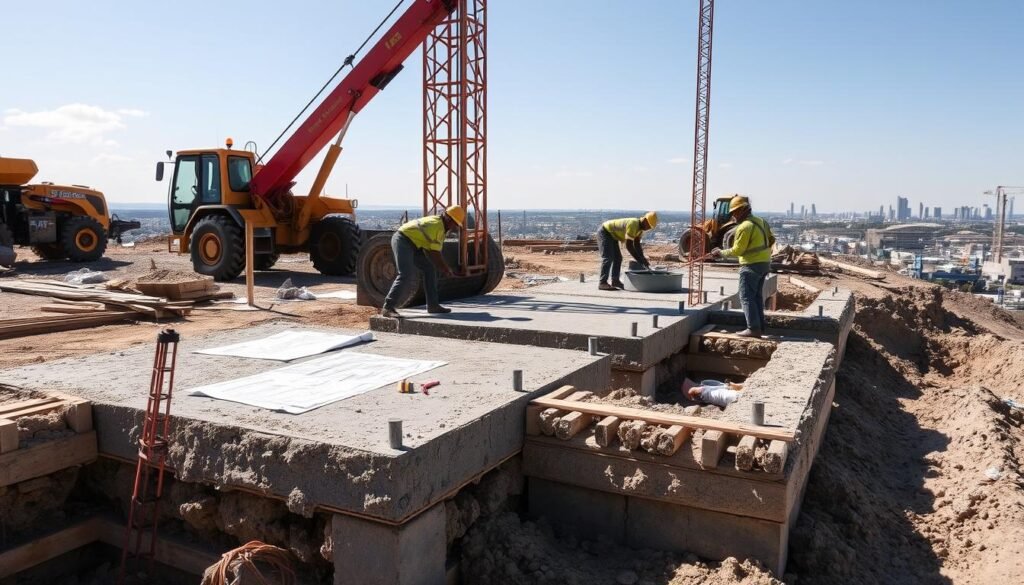Building something strong is very important. The idea of building on sand shows the dangers of weak bases. In Matthew 7:24-27, a house on rock and one on sand show big differences when things get tough1.
This shows that a solid base leads to lasting success. But, a weak base can cause big problems2.
Key Takeaways
- Building on sand symbolizes unstable foundations that can lead to structural integrity issues.
- Matthew 7 highlights the importance of solid foundations for withstanding adverse conditions1.
- Unstable foundations can make buildings susceptible to everyday troubles, life-threatening disasters, and the power of words2.
- Proper groundwork ensures long-term building stability.
- Daily attention to foundational elements can strengthen and maintain stability2.
The Risks of Building on Unstable Foundations
Building on shaky ground is risky. It can make structures unsafe and weak. Knowing these risks helps avoid disasters and makes sure buildings are strong.
Understanding Shaky Foundations
A building’s foundation must be stable. A shaky foundation can happen for many reasons. Poor soil, bad building methods, and weather can all play a part.
Soil like clay can make buildings sink or tilt. But, soil with gravel or sand can better handle earthquakes3. This shows why soil tests and good foundation designs are key.
Examples of Unstable Foundation Risks
History shows the dangers of shaky foundations. The 1964 Alaska earthquake caused buildings to fall and a lot of damage4. The 1989 Loma Prieta earthquake in San Francisco also showed how bad soil can be4.
Building codes are important to avoid these problems4. They help make sure buildings are safe.
Studies show that strong materials like steel and concrete help buildings stay up during earthquakes3. Deep foundations are also better than shallow ones3. For example, Christchurch’s buildings were damaged in the 2010 earthquake because of bad soil4.
It’s clear that solid foundations are crucial. They help buildings stay safe during earthquakes. Builders must follow rules and use good materials to avoid shaky foundation problems.
To learn more about something completely different, check out this article. It talks about how Old Testament prophecies came true in Jesus’ life.
Building Your House on Sand: Why a Shaky Foundation Leads to Ruin
Building a house on shaky ground can end badly. This is seen in old buildings that were poorly made. Through stories and real-life examples, we see the dangers.
Historical Perspectives on Shoddy Construction
Many old buildings were built on weak foundations. This led to big problems. The Bible talks about a house on rock versus sand. The house on sand falls down hard56.
This shows how important a strong base is. Old bad building methods often caused big failures.
The Long-term Effects of Building on Sand
Building on sand has very bad long-term effects. The Bible says Jesus is like a strong foundation6. It also talks about houses on sand versus rock.
This shows that ignoring the base can cause huge damage. The chance of a house falling is very high5. Bad building makes a structure weak and unstable.
Stories in the Bible warn about bad foundations. Matthew 7:24-27 says a house on sand falls hard56. This is true for buildings too. Neglecting the base can cause big problems later.
To learn more about foundations in life and building, check out here.
Structural Integrity: Why It Matters
Structural integrity is key in building and life. It makes things last and strong against outside forces. The base of a building is very important for its life span and how well it works.
The Role of a Solid Foundation
A strong base is crucial. It holds up the whole building above it, keeping it stable. Building on a solid base is smart, like Jesus said in Matthew 7:24-277.
It keeps things steady during tough times7. The building world uses steel, concrete, and forms to make things firm8. It shows how important a strong base is, like in buildings and life7.
The story of the wise man and the foolish man teaches us about strong bases9. It shows how faith and following rules help build a strong base9.
Impact on Overall Building Stability
Structural integrity helps buildings stand up to big storms and shakes78. The big quake in San Francisco in 1906 showed how important solid bases are in shaky places8. It showed what happens when you ignore this8.
Proverbs 12:7 teaches us about the importance of a strong base8. Following God’s teachings helps build a strong base. It lets us face life’s challenges7.
For more on building a strong base and keeping things stable, check out our detailed discussion on foundations in building and life.
Types of Unsuitable Soils for Construction
Building on the wrong soil can cause big problems. Soils that liquefy or have lots of sand and clay are bad. Knowing about *soil contamination* and high water tables is key for a strong foundation.
Soil Contamination Issues
Some soils turn to liquid when shaken, like during an earthquake. This has happened in big quakes, damaging many bridges10.
Soil can also get contaminated by chemicals. This wasn’t a big worry until the 1960s. Clays that can’t hold water well are unstable and can fail10. To fix this, we avoid bad soils and use special methods to make them stable10.
High Water Tables and Their Implications
A high water table makes soil bad for building. Too much water makes soil settle fast, which is bad for clay or sandy soil11. It’s important to check the soil before building11.

Building where the water table is high needs extra care. Weather changes and freezing can make the soil unstable. This can cause problems like cracks in walls and doors that don’t close right11. Spotting these problems early and getting help can prevent big damage.
For more on the *Beatitudes* and their timeless wisdom, check out this link.
Construction Mistakes to Avoid
Construction mistakes can cause big problems. They are often seen in the early stages of building. Knowing about soil and following expert advice can help avoid big issues.
Overlooking Soil Evaluation
Not checking the soil is a big mistake. It’s key to know what kind of soil you have. If you don’t test the soil, your building might not be stable.
Building on the wrong soil can lead to cracks. This is because some soils change size a lot. Testing the soil helps make sure your foundation is strong.
Ignoring Geotechnical Recommendations
Ignoring advice from geotechnical experts is another mistake. These experts know a lot about soil and building design. Not listening to them can make your building weak.
For example, not following advice on strong foundations can be bad. This can make your building shaky. It’s important to listen to these experts to keep your building safe.
Also, earthquakes are a big worry in many places. Most earthquakes happen where big plates meet. Without good advice, buildings might not be safe during these events.
Following these steps helps keep your building safe and strong. It also makes sure it lasts a long time. So, checking the soil and listening to experts are very important.
- Do a full soil check before you start building.
- Always follow the advice of geotechnical experts.
- Think about earthquakes when you design your foundation.
| Common Construction Mistakes | Potential Consequences | Recommended Practices |
|---|---|---|
| Overlooking Soil Evaluation | Structural instability, foundation cracks | Perform thorough soil testing |
| Ignoring Geotechnical Recommendations | Weak foundations, compromised building integrity | Follow expert advice rigorously |
| Neglecting Seismic Considerations | Catastrophic failures during earthquakes | Design earthquake-resistant structures |
Proper Groundwork: Laying the Foundation Right
Proper groundwork is key for any project. It makes things last longer and stay strong. It starts with soil analysis and the help of soil engineers.
Importance of Soil Analysis
Soil analysis is very important. It tells us what the soil is like, how wet it is, and how dense. Digging 6 inches deep is a good start for new buildings to stay steady12.
Grading and digging are important for stability. Using polymeric sand in joints helps things stay in place12. This keeps the foundation strong against the weather.

Role of Soil Engineers
Soil engineers are very important. They check the site and tell us how to make it stable. They use tools and make sure everything is set right12.
They also check how strong the soil is. This helps avoid problems and tells us if we need to treat the soil.
Knowing about soil analysis and using soil engineers helps a lot. It makes sure the foundation is strong. This means the project will last longer and face fewer problems.
For more on laying a strong foundation, see how Jesus met Old Testament predictions here13.
Foundation Repair and Maintenance Tips
Keeping your foundation stable is key for your home’s safety and life. Knowing how to spot damage and fix it can save you money later.
Identifying Signs of Foundation Damage
Spotting damage early can prevent big, costly fixes. Look for big cracks in walls, doors and windows that don’t line up, gaps between ceilings and walls, and floors that shift. If you see these signs, get a pro to check it out fast11.
Techniques for Effective Foundation Repair
There are many ways to fix a foundation, depending on the damage and soil. Pier and beam systems are strong, great for beach homes. Pilings also work well for these homes14.
For homes on water tables or sandy soil, make sure the foundation is deep enough. Sandy soil needs deeper foundations to stay stable14. Insulated Concrete Forms (ICFs) are good for energy saving and can withstand hurricanes14.
In earthquake areas, foundations can settle more. Concrete is better than wood or steel for this11. Soil changes with seasons, affecting settling. If your home settles too much, get it checked right away11.
Julian Construction has done over 30,000 foundation checks in LA. They say regular checks are key to catching problems early15. Using sister foundations helps keep old buildings stable15.
Fixing your foundation right means knowing your soil and environment. Use the right fixes and watch for damage to keep your home safe. For more tips, visit this site.
Conclusion
A strong foundation is very important. Jesus taught us that a good base is key for success. This is true for building houses and for life’s challenges.
Nate Wilson’s sermon at Christ the Redeemer Church showed us why a solid base matters. He used stories and the Bible to make his point16. Jesus also taught about the difference between wise and foolish builders17.
Today, we use quality materials and inspections to build strong. Insurance is also important17
Building a house or a life based on Jesus’ teachings needs a strong foundation. Learn more about Jesus and the Law at this resource. By following good practices, we make our foundations strong. This is what sustainable building and integrity are all about.
